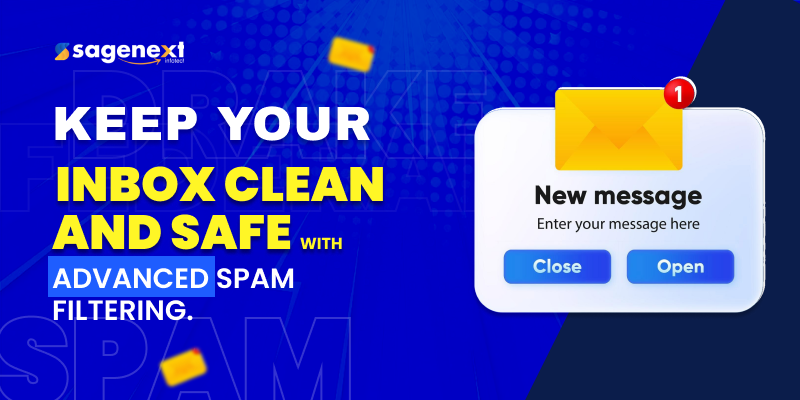For businesses globally, emails are a prime mode of communication with customers and employees. However, this preferred method of sending and receiving electronic messages has become severely infected with high percentages of unsolicited and unwanted information known as Spam Messages or Emails.
A Study On Email Spam Filtering by Christina V, Karpagavlli S, and Suganya G, states “Email spam, also known as unsolicited bulk Email (UBE), junk mail, or unsolicited commercial emails (UCE), is the practice of sending unwanted email messages, frequently with commercial content, in large quantities to an indiscriminate set of recipients.”
Fortunately, spam filters are becoming increasingly popular in the email delivery process. With more smartness and robustness, spam filtering is the preferred choice among industries. Before proceeding with the details, let's discuss what is spam, and its types.
What is Spam?
Generally, we accept spam as a normal part of electronic communication because we face it frequently, which should not be the case. The word Spam means digital junk, and when we say junk, it involves all unrequested or unwanted content like messages, SMSs, emails, or texts. Now you know what spam content is, it is necessary to understand what spamming is to detect it if it ever happens to you.
When a source ( a person or a website) keeps sending you unwanted and unsolicited content via emails, texts, or SMSs, that act is known as Spamming, and the person responsible for continuously sending digital junk is called a Spammer.
Spams are not only limited to emails or text messages, but there is a variety of spam given below:
Email Spams:
As the name implies, email spams are found in your email inboxes. It fills up your inbox distracting you from your important emails. People generally ignore it or keep deleting it.
SEO Spams:
SEO Spam is another term for spamdexing that is used as a rigged method to optimize the search rankings. SEO Spam is further bifurcated into two categories:- Content Spam and Link Spam.
Social Media/Networking Spam:
Social media and networking spammers take full advantage of the growing dependencies on social media. You will face many posts trying to spam you in the name of any product, giveaways, etc.
Messaging/SMSs/Texts Spams:
You all must know about this one as it's the most common type of spam. Spammers send unwanted junk to your WhatsApp, Messages, Snapchat, etc. instantly.
For our rescue, Spam Filtering is an existing solution to this issue of spam. Let's discuss what Spam Filtering is in our next section.
What is Spam Filtering?

Lately, spam has become so common that people no longer consider it an inconvenience but compromise with the situation like switching off the notifications for the same. However, Spam Filtering is a program or a method that detects or filters out junk or unwanted content from important emails or messages. Spam Filters segregate messages into either spam folders or discard them based on their types. Suppose if the content is vague and seems unsolicited then it's probably going to be discarded by spam filtering.
Many spam filtering tools are used by businesses, Internet Service Providers (ISPs), email services, etc., to reduce the risk of spam. A lot of spam filters are available cloud-based, on computers, or integrated.
Microsoft Hotmail used a classic example of a spam filtering tool, which also happens to be one of the earliest versions of spam filtering, in which the filter recognized a bunch of words (mostly considered spam words) in the received email and automatically tagged them as spam emails. But, technology is not so easy to fool. With the growing smartness of spam messaging, this option is no longer effective as it results in false positives while letting the actual spam content pass through.
However, several types of spam filters can be used by businesses to filter out the junk from their important messages or emails.
Types Of Spam Filters

There are many types of spam filters specialized in filtering, blocking, or discarding vague content. The list of different spam filters is given below:
 Rule-Based Filters
Rule-Based Filters
There is a defined set of rules and regulations upon which the rule-based filters work. In simpler terms, you can set up some rules that will be automatically applied to all the emails landing in your inbox. This filter is also used to target specific senders.
 Content Filters
Content Filters
Content filters act according to the content present inside of an email or text message by going through the content and deciding whether or not the content is spam. However, the content of any email or message is easily predictable due to similar objectives like a discount, offers, etc. After reviewing the content of your email, content filters tag them with either spam texts or important texts.
 Header Filters
Header Filters
Header filters are just like how the name goes as these filters tell if an email is spam or not by analyzing the headers. This may also include Internet Protocol (IP) addresses as this is mostly used by spammers.
 Language Filters
Language Filters
Spam emails don't always come from within the respective country. At times, these spammers target an international audience, hence the emails they send are also in their language. If this happens, there are language filters that filter out the alien languages and discard them. But, if you're expecting such emails you can always check your spam folders.
 Bayesian Filters
Bayesian Filters
Bayesian filters are very structured spam filters that can easily learn about your preferences automatically by analyzing the content you tag as spam. After observing your pattern, Bayesian sets up your pattern-friendly rules on its own. If you receive an email similar to this, the Bayesian filter will move it into the spam folder.
 Blacklist/Whitelist Filters
Blacklist/Whitelist Filters
The filtering under Blacklist/Whitelist filters is done based on already known spammers. These filters work in two ways- either it will accept emails from only whitelisted sources, or block the emails coming from the blacklisted sources.
What Is Inbound Spam Filtering?
Inbound emails are the emails that directly land in your inbox, and when spam messages are segregated from the inbound emails, it is known as Inbound Email Filtering. In many cases, spam messages don't land in your inbox in the first place, as inbound filters start to discard unsolicited content immediately.
If you consider the increasing percentage of spam messages, you'll know why Inbound Spam Filtering has become so necessary. It helps keep your inbox safe and secure from unwanted and vague content. Inbound Email Filtering plays an important role in identifying the sender's IP address to locate its origin.
Inbound Spam Filtering keeps an authentic track of senders' information as it successfully locates the respective IP addresses, and the chances of false/fake IP addresses are low. So, overall it becomes easier to manage the senders' information through Inbound Spam Filtering. It is more like protecting you from cybercrimes or attacks rather than discarding unsolicited content. With this, inbound spam filtering saves you lots of time because you don't have to deal with unnecessary spam texts or discard them.
What Is Outbound Spam Filtering?
Outbound Spam Filtering addresses the challenge of blocked IP addresses. It helps identify senders/individuals based on their credentials. The spammers can easily manipulate your email or user IDs to send spam texts from your email address. No spam should be left unchecked or untreated in the outbound, if not done then the internet blocks the entire network of the service provider. Organizations try hard to secure their networks and systems.
However, spammers can find ways to infiltrate your network to use it for purposes like spamming. To deal with this challenge, Outbound Spam Filtering exists. It is programmed in a way that helps identify individual users with their authentic credentials such as passwords. Outbound Spam Filtering identifies spam-like behavior and prevents your network's IP address from getting leaked.
In some ways, inbound spam is a result of outbound spam. So, having outbound spam filtering can lower the chances of inbound spam because it blocks the spam emails at their source itself.
How Can Spam Filters Help You?
By now, you all must know that a spam filter helps quarantine unsolicited and unwanted content from your legitimate emails. Spam filters have a few other features/benefits that can help an organization in many ways, such as:
Quarantines Trash/Spam Emails
The foremost feature of a spam filter is to detect and discard unsolicited messages and emails. Spammers are getting good with technologies so the basic spam protection level of emails is not sufficiently effective. That's why spam filters are required.
Spam filters enable users to distinguish between an approved and unapproved email address. When this happens, emails that come from approved/white email addresses land in the inbox, and if the address is unapproved or blacklisted spam filters discard the content.
Allows Legitimate Content
You don't have to worry about the legitimacy of the content you're receiving when you're using spam filters. The vague or spam content is either blocked at the source or discarded when it lands in your inbox. Spam filters, depending upon the type of the emails, decide whether to move them to the trash or to discard them.
This keeps your inbox free of spam emails and you only see the legitimate emails. Spam filters help keep your inbox clean and get rid of all the unnecessary content at once.
Time-Saving
With spam filters, organizations save a lot of time on their hands. They no longer need to deal with the stress of manually discarding the trash or spam emails from their legitimate emails. Spam filters take care of it automatically.
This feature saves many organizations time and can invest that into something more productive. Everything from detecting digital junk to discarding them takes not more than a few minutes with spam filters.
Money-Saving
There is an increased number of email phishing where scammers try to fool you via spam emails and get your details regarding credit card, be it a personal or private one, leaked. No matter what the card is, the result is always going to be the loss of hard-earned money.
Using spam filters, in such cases, is a great choice, as spam filters are affordable as well as trustable. It makes your inbox a safe place where you get emails related to work and not scams
Why Do You Need Spam Filters?
The issue of growing spam emails and messages is not limited to just one industry but it is a growing concern in almost every industry. Nobody wants to spend hours and hours manually discarding junk emails and messages. Spam filtering is a technical mechanism that takes over the hustle of manual junk email discarding, keeping the inbox free of spam, allowing legitimate content, etc.
Its advanced features and API version make it a great choice among industries and organizations. Spam filters support various features that are useful for every industry. The list of features is given below:
Machine Learning Algorithm:
It detects whether the content is legitimate or vague. Through Machine Learning Algorithms, it is easy to discard spam or trash emails.
Scoring Spam:
It follows an advanced algorithm by assigning a 0-6 scale to each content. The higher the scale, the more the chances of spam.
Spam Word Detection:
This works based on some set of words defined as spam words. If the filter finds similar words in the emails, it is categorized as spam email.
Blacklist IPs List:
This version keeps an updated track of frequent spamming IDs and their IP addresses. The next time they try to send you a spam email, spam filters detect it and discard it or categorize it as spam.
Language Outlier Detection Algorithm:
This algorithm works based on language included in the content. If the language seems to be a part of spam messaging, the email does not get through your inbox.
If you read the above-mentioned points carefully, you'll come to realize the importance of Spam Filters. It is the sole source of controlling frequent spam in no time. Not just this, spam filters can also be used in controlling phishing attacks. We, so far, don't see a single reason why you shouldn't use it.
What Makes The Best Spam Filtering Service?
You should always go for the service that provides you with the best of its limit, as there are a few things that need to be verified when choosing the best spam filtering services. The most prominent one is several layers of security features that help in preventing spam, attacks, phishing, threats, etc. Having a reliable set of security layers helps protect organizations against malware and ransomware attacks.
Spam filters are not made of one feature, several features contribute to their goodness. What might become confusing for users is deciding which factors should be given more weight when choosing spam filtering services. If you break down the essential purpose of filtering, you'll realize that it should have high spam and junk detection rate followed by convenient use.
Cost should have a mandatory lookout, as you also choose according to your budget. The best spam filtering services have good outbound scanning and it does not let the junk enter your network. A good outbound scanning blocks the spam at the source itself. All these factors should be looked for when searching for the best spam filtering services.
Best Tools/Software for Spam Filtering (Free/Paid)

Mass presence always leads to confusion. There is a wide variety of spam filtering options in the market, but which one to go for is a little confusing. If you're struggling with the conflict of choice, read the following section.
Here we'll be discussing 5 best tools/software for spam filtering:
 SpamTitan (TitanHQ)
SpamTitan (TitanHQ)
SpamTitan, founded in 1995, is a very suitable option as it suits every industry. Its features include email scanning, blocking spam, threats prevention or blockage, links and attachments scanning, etc. It is affordable as the introductory pricing starts at just $0.80/month. SpamTitan offers a one-month free trial with various benefits such as 24/7 support, encryption, email recovery, etc.
 ZEROSPAM
ZEROSPAM
ZEROSPAM works for large and medium-sized organizations by using reseller channels. It has worked with fantastic tech companies such as TechData, CPU, etc., and it's a cloud-based platform. That means you don't have to install it on your systems. ZEROSPAM claims to be the best platform for spam filtering with superior ransomware and malware protection. The benefits of using ZEROSPAM are encryption, email recovery, webinars training, etc.
 Spambrella
Spambrella
No matter if the customers are resellers or end-users, Spambrella serves all. Being a SaaS company, it provides versatile spam filtering solutions and everything is hosted in the cloud. You get several training opportunities with Spambrella with free trials. The benefits include encryption, email recovery, fraud or spam detection, etc.
 MailChannels
MailChannels
MailChannels helps reduce spam or junk emails and messaging. Being a cloud-based filtering platform, it does not need to be installed on the systems. It also makes sure that their emails land in the inbox and not in the spam folder. It provides 24/7 support, encryption, spam detection, etc.
 Xeams
Xeams
Irrespective of the industry's size (small, big, or medium), Xeams fits all types. It was founded back in 2002 that claims to remove 99% of the junk or spam emails from your account. Available for both Windows and MAC users, Xeams is the ideal spam filtering platform. The benefits include email routing, spam detection, encryption, mass email manager, etc.
Final Thoughts
Spam emails and messages have been a nuisance ever since their evolution. You all must know the feeling of getting irritated when someone continuously sends you irrelevant content. Employees can end up spending hours and hours of their productivity searching and discarding spam emails. At times, they even delete legitimate emails by mistake. Spam filtering comes to play in such cases. Being a junk detector, spam filters either block the spam at their sources or discard them automatically once they enter your network. There are a variety of spam filters in the market all with different but effective features and benefits. In today's time, when spamming has become so common we'll recommend you to start using one as a means of network protection.
FAQs
How does Yahoo filter spam?
Yahoo scans every email to differentiate between spam and legitimate emails. It looks for specific signals like blacklisted IP addresses, user complaints, etc., and if it finds any, that content goes to the spam folder. It uses SpamGuard.
How does Outlook detect spam?
Outlook does not learn it through your blocked messages algorithm, rather the junk emails definition is set and updated by Microsoft through Microsoft Update monthly.
What is email content filtering?
Email content filtering is a program that filters out emails based on spam or legitimate emails. It analyzes the incoming emails and then moves forward with discarding them or keeping them.
How do companies block spam emails?
Every company follows 5 basic steps to block or eliminate spam content from their network- spam markings, deleting spam, keeping email addresses private, third-party spam filters, changing email addresses, and unsubscribing from email lists.
What if I get spam or malware from someone on the approved senders' list?
If you get spam content from an approved sender's list, the email or the content will land in your inbox instead of going to the spam folder.
What is an email impersonation attack?
An Email impersonation attack occurs when an email comes, seemingly to be from a reliable or authentic source but is spam content. Such email scams are even called Whaling Email Scams.
How can you block email impersonation attacks?
Email filtering solutions like Egress Defend are a way to protect your organizations from email impersonation attacks. It can protect your organization from issues like email takeover.
What is Spam Risk?
The phrase “Spam Risk” means that your system has recognized a move from a spammer and warns you that it is an unwanted activity. For eg: your phone identifies and categorizes an incoming call as unwanted after showing Spam Risk.
If you liked our blog and don't want to miss out on similar content, do not forget to visit our official website as many such informative tech blogs are waiting for you. For any queries, please contact our support team whenever you want. Thank You!
These carefully selected partners contribute their expertise in technology, infrastructure and support solutions, enhancing reliability and performance. Through this collaboration, Sagenext delivers a dependable and efficient hosting environment, allowing users to work without disruptions and enjoy optimal stability and security.












Sagenext has consistently garnered distinguished recognition for its exceptional hosting services, characterized by a resolute dedication to innovation and customer delight. This unwavering commitment to excellence has been demonstrably acknowledged through the receipt of numerous prestigious awards and accolades, solidifying Sagenext's position as an industry leader.
 Great Uptime by HostAdvice
Great Uptime by HostAdvice Great User Experience by Finances Online
Great User Experience by Finances Online Rising Star Award by Compare Camp
Rising Star Award by Compare Camp Top 10 Cloud Hosting Host Advice
Top 10 Cloud Hosting Host Advice

